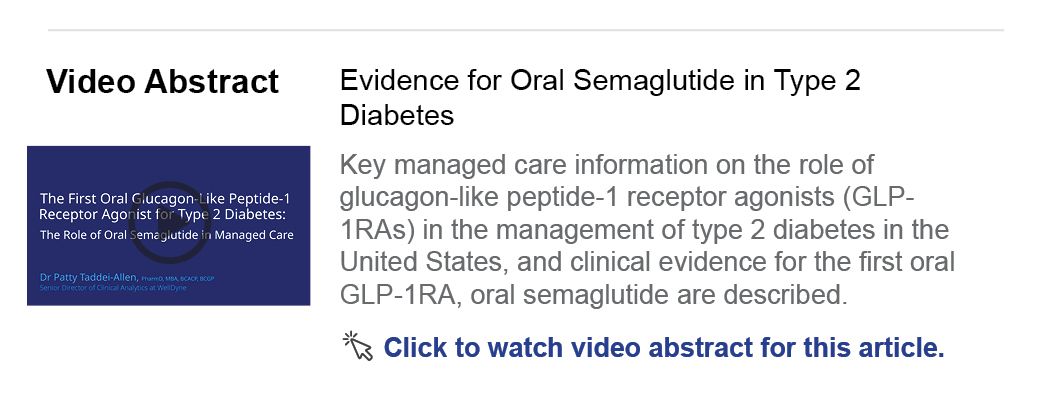- Center on Health Equity & Access
- Clinical
- Health Care Cost
- Health Care Delivery
- Insurance
- Policy
- Technology
- Value-Based Care
The Evidence for Oral Semaglutide in Type 2 Diabetes From a Managed Care Perspective
Diabetes represents a major and growing challenge. It is estimated to affect 34 million US adults, with type 2 diabetes (T2D) accounting for more than 90% of cases.1 There are substantial downstream consequences of uncontrolled T2D, including microvascular complications that place patients at risk of chronic kidney disease, diabetic retinopathy, and diabetic neuropathy.2 As a result, diabetes is a leading cause of kidney failure, blindness, and lower-extremity amputations.1,2 In addition, the risk of cardiovascular disease (CVD) is increased 2- to 3-fold by the presence of T2D,3 with CVD being the leading cause of death in this population.4
As a consequence of the high prevalence of T2D and downstream complications, T2D imposes a substantial burden on US health care systems. Early and improved glycemic control can lead to lower health care costs, and reduce the lifetime risk of developing complications.5,6 In patients with newly diagnosed T2D, failure to attain early glycemic control has been associated with increased microvascular and macrovascular events, and an increased risk of death.6 Thus, early achievement of glycemic control (within 1 year of a T2D diagnosis) is important to reduce the risk of long-term complications in T2D.6 An array of glucose-lowering therapies are now available to help achieve this, and these agents are administered across a range of patient populations at varying stages of the disease trajectory.7
This supplement presents key information for those working in the managed care setting, provides an up-to-date synopsis of the burden of T2D in the United States, and reviews the role of glucagon-like peptide-1 receptor agonists (GLP-1RAs) in the management of T2D, before appraising the clinical evidence for the first oral GLP-1RA, oral semaglutide. Drawing on data from the phase 3a PIONEER clinical trial program, which generated data for oral semaglutide in over 9500 patients with T2D in a range of clinical settings, we explore the efficacy of oral semaglutide in terms of glycemic control and body weight, assess cardiovascular (CV) outcomes, discuss the safety and tolerability profile of oral semaglutide, and describe patient-reported outcomes. Throughout, the clinical evidence for oral semaglutide is placed in context with that available for other therapeutic options, including injectable GLP-1RAs.
In the first article,8 Drs Dougherty and Heile review the burden of T2D in the United States, emphasizing the high direct medical costs related to diabetes (estimated to total $237 billion in the United States in 2017), which are primarily driven by prescription medication costs for antidiabetic agents, hospital inpatient and outpatient care, and physician office-based care, and describe indirect costs.4 This socioeconomic burden is compounded by a further $90 to $250 billion in indirect costs, such as lost productivity.4,9 The authors also explore the role of GLP-1RAs and the challenges of clinical inertia and poor adherence, and the rationale for an oral GLP-1RA, in the context of considerations for managed care.
GLP-1RAs have been in clinical use for over a decade,10 and are associated with high glucose-lowering efficacy and neutral or low risk of hypoglycemia, and promote weight loss.7,10,11 Despite these known benefits, they remain a relatively underutilized class of medication,12 which may relate in part to the injectable route of administration and their relatively high cost.7,13 In light of this, the 2019 approval of the first tablet formulation of a GLP-1RA, oral semaglutide,14 could lead to earlier and more widespread use of the GLP-1RA modality.
To select the most appropriate therapy for each patient and tailor treatment for those with pre-existing conditions such as CVD, it is important to consider not only glycemic control and body weight, but the drug’s safety profile and other factors, such as patient preferences and costs.7,11 In the second article,15 Drs Rodbard, Dougherty, and Taddei-Allen describe the PIONEER phase 3a clinical trial program with a focus on the efficacy results and their implications for managed care specialists. Several GLP-1RAs have been shown to reduce the risk of CV events in T2D, and they are recommended in patients with established CVD, and in those at high risk of CVD.7,11 In the third article,16 Drs Lingvay, Taddei-Allen, and Dougherty review the evidence for CV outcomes with oral semaglutide, explore the safety profile of oral semaglutide across the clinical trial program, and discuss its use in specific patient populations.
Beyond these clinical outcomes, T2D significantly impairs patients’ health-related quality of life (HRQOL), affecting physical and mental functioning, and social interactions.17 The development of complications or coexistence of comorbidities are significant contributors to the negative impact of T2D on HRQOL, as are weight gain and episodes of hypoglycemia (typically associated with insulin or insulin secretagogue use).18,19 The assessment of patient-reported outcomes is increasingly utilized in clinical trials, and it can complement clinical outcomes and significantly contribute to treatment decisions in daily practice. The final article20 by Drs Schneider, Taddei-Allen, and Dougherty focuses on patient experiences, reflecting on how patient-reported outcomes can inform decision-making in managed care, and examines the effect of oral semaglutide on such outcomes.
Acknowledgments
This article was supported by Novo Nordisk Inc; the company was provided with the opportunity to perform a medical accuracy review. Under the direction of the authors, medical writing and editorial support was provided by Nicole Cash of Axis, a division of Spirit Medical Communications Group Limited (funded by Novo Nordisk Inc).
Author affiliations: TriHealth Physician Partners (MH); WellDyne (PTA).
Funding source: Financial support for this work was provided by Novo Nordisk Inc.
Author disclosures: Dr Heile has served as a speaker for and holds stock in Novo Nordisk Inc. Dr Taddei-Allen is an advisory board member for Novo Nordisk Inc.
Authorship information: Drafting of the manuscript (MH, PTA); critical revision of the manuscript for important intellectual content (MH, PTA); responsibility for content (MH, PTA).
Address correspondence to: Michael Heile, MD, FAAFP, 6331 Glenway Ave, Cincinnati, OH 45211. Email: Michael_Heile@trihealth.com. Phone: +1 513 389 1400.
References
1. Centers for Disease Control and Prevention. National diabetes statistics report, 2020: estimates of diabetes and its burden in the United States. Centers for Disease Control and Prevention, U.S. Department of Health and Human Services. 2020. Accessed April 7, 2020. https://www.cdc.gov/diabetes/pdfs/data/statistics/national-diabetes-statistics-report.pdf
2. American Diabetes Association. 11. Microvascular complications and foot care: Standards of Medical Care in Diabetes-2020. Diabetes Care. 2020;43(suppl 1):S135-S151. doi:10.2337/dc20-S011
3. Al-Salameh A, Chanson P, Bucher S, et al. Cardiovascular disease in type 2 diabetes: a review of sex-related differences in predisposition and prevention. Mayo Clin Proc. 2019;94(2):287-308. doi:10.1016/j.mayocp.2018.08.007
4. American Diabetes Association. Economic costs of diabetes in the U.S. in 2017. Diabetes Care. 2018;41(5):917-928. doi:10.2337/dci18-0007
5. Bansal M, Shah M, Reilly B, et al. Impact of reducing glycated hemoglobin on healthcare costs among a population with uncontrolled diabetes. Appl Health Econ Health Policy. 2018;16(5):675-684. doi:10.1007/s40258-018-0398-2
6. Laiteerapong N, Ham SA, Gao Y, et al. The legacy effect in type 2 diabetes: impact of early glycemic control on future complications (the Diabetes & Aging Study). Diabetes Care. 2019;42(3):416-426. doi:10.2337/dc17-1144
7. American Diabetes Association. 9. Pharmacologic approaches to glycemic treatment: Standards of Medical Care in Diabetes-2020. Diabetes Care. 2020;43(suppl 1):S98-S110. doi:10.2337/dc20-S009
8. Dougherty T, Heile M. Type 2 diabetes in the US managed care setting: the burden of disease and rationale for an oral glucagon-like peptide-1 receptor agonist. Am J Manag Care. 2020;26(suppl 16):S325-S334. doi:10.37765/ajmc.2020.88552
9. Shrestha SS, Honeycutt AA, Yang W, et al. Economic costs attributable to diabetes in each U.S. state. Diabetes Care. 2018;41(12):2526-2534. doi:10.2337/dc18-1179
10. Nauck MA, Meier JJ. Management of endocrine disease: are all GLP-1 agonists equal in the treatment of type 2 diabetes? Eur J Endocrinol. 2019;181(6):R211-R234. doi:10.1530/EJE-19-0566
11. Garber AJ, Handelsman Y, Grunberger G, et al. Consensus statement by the American Association of Clinical Endocrinologists and American College of Endocrinology on the comprehensive type 2 diabetes management algorithm - 2020 Executive Summary. Endocr Pract. 2020;26(1):107-139. doi:10.4158/CS-2019-0472
12. Montvida O, Shaw J, Atherton JJ, et al. Long-term trends in antidiabetes drug usage in the U.S.: real-world evidence in patients newly diagnosed with type 2 diabetes. Diabetes Care. 2018;41(1):69-78. doi:10.2337/dc17-1414
13. Spain CV, Wright JJ, Hahn RM, et al. Self-reported barriers to adherence and persistence to treatment with injectable medications for type 2 diabetes. Clin Ther. 2016;38(7):1653-1664.e1. doi:10.1016/j.clinthera.2016.05.009
14. FDA approves first oral GLP-1 treatment for type 2 diabetes. News release. U.S. Food & Drug Administration. September 20, 2019. Accessed June 1, 2020. https://www.fda.gov/news-events/press-announcements/fda-approves-first-oral-glp-1-treatment-type-2-diabetes
15. Rodbard HW, Dougherty T, Taddei-Allen P. Efficacy of oral semaglutide: overview of the PIONEER clinical trial program and implications for managed care. Am J Manag Care. 2020;26(suppl 16):S335-S343. doi:10.37765/ajmc.2020.88554
16. Lingvay I, Taddei-Allen P, Dougherty T. Cardiovascular outcomes, safety, and tolerability with oral semaglutide: insights for managed care. Am J Manag Care. 2020;26(suppl 16):S344-S355. doi:10.37765/ajmc.2020.88555
17. Trikkalinou A, Papazafiropoulou AK, Melidonis A. Type 2 diabetes and quality of life. World J Diabetes. 2017;8(4):120-129. doi:10.4239/wjd.v8.i4.120
18. Pawaskar M, Iglay K, Witt EA, et al. Impact of the severity of hypoglycemia on health - related quality of life, productivity, resource use, and costs among US patients with type 2 diabetes. J Diabetes Complications. 2018;32(5):451-457. doi:10.1016/j.jdiacomp.2018.01.012
19. Marrett E, Stargardt T, Mavros P, Alexander CM. Patient-reported outcomes in a survey of patients treated with oral antihyperglycaemic medications: associations with hypoglycaemia and weight gain. Diabetes Obes Metab. 2009;11(2):1138-1144. doi:10.1111/j.1463-1326.2009.01123.x
20. Schneider D, Taddei-Allen P, Dougherty T. The importance of patient-reported outcomes in type 2 diabetes: insight from the PIONEER program with oral semaglutide. Am J Manag Care. 2020;26(suppl 16):S356-S367. doi:10.37765/ajmc.2020.88556


